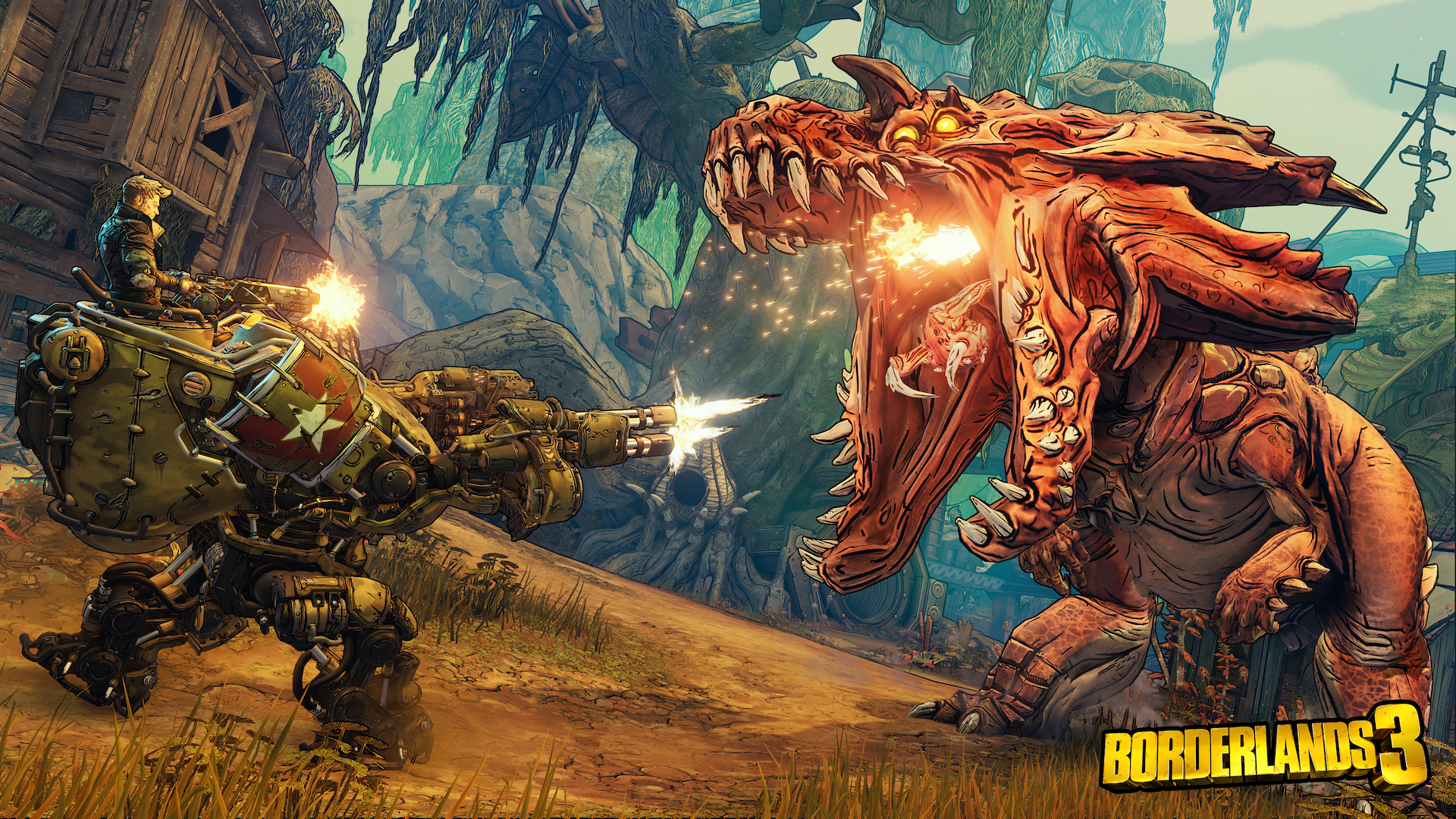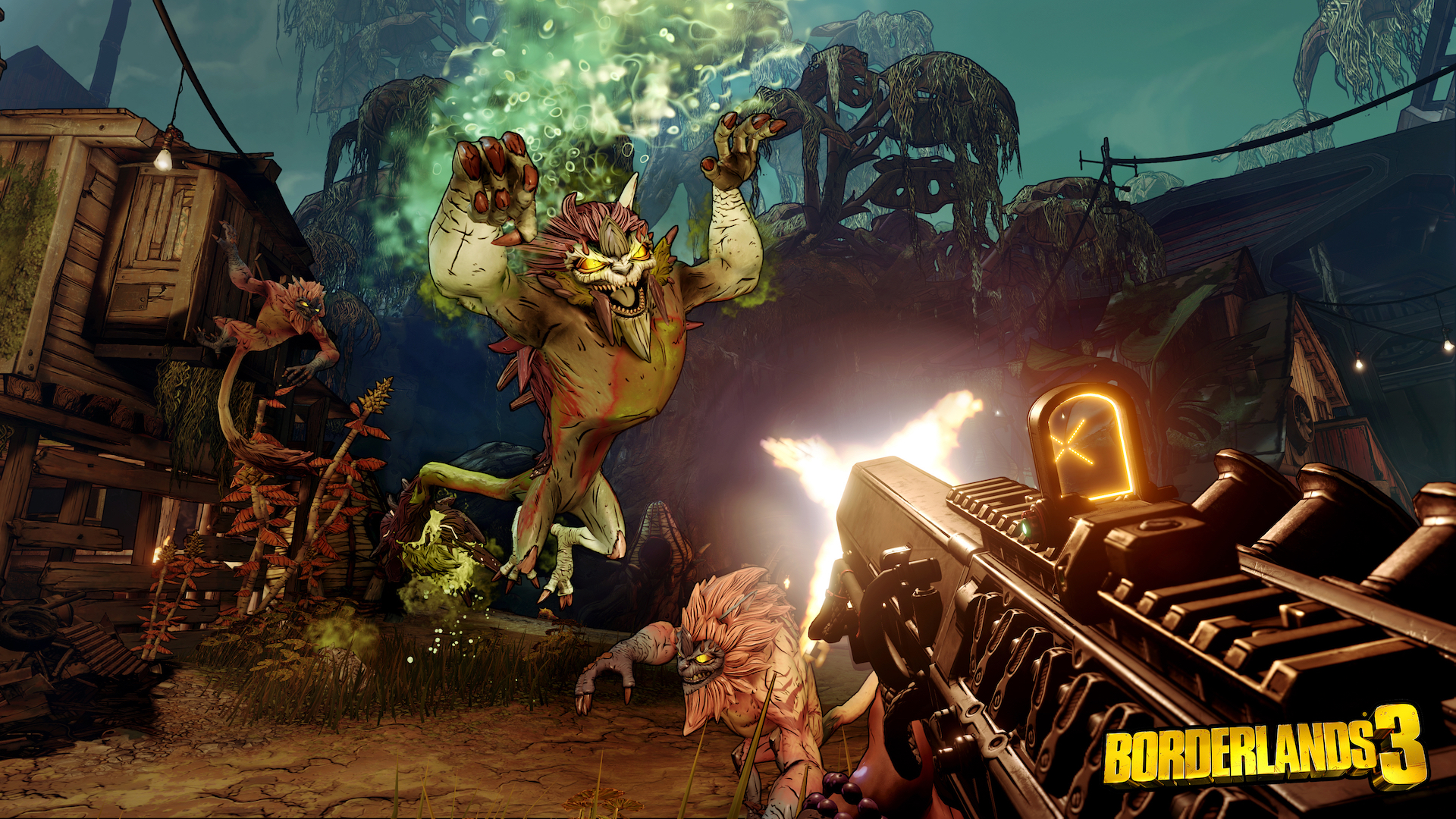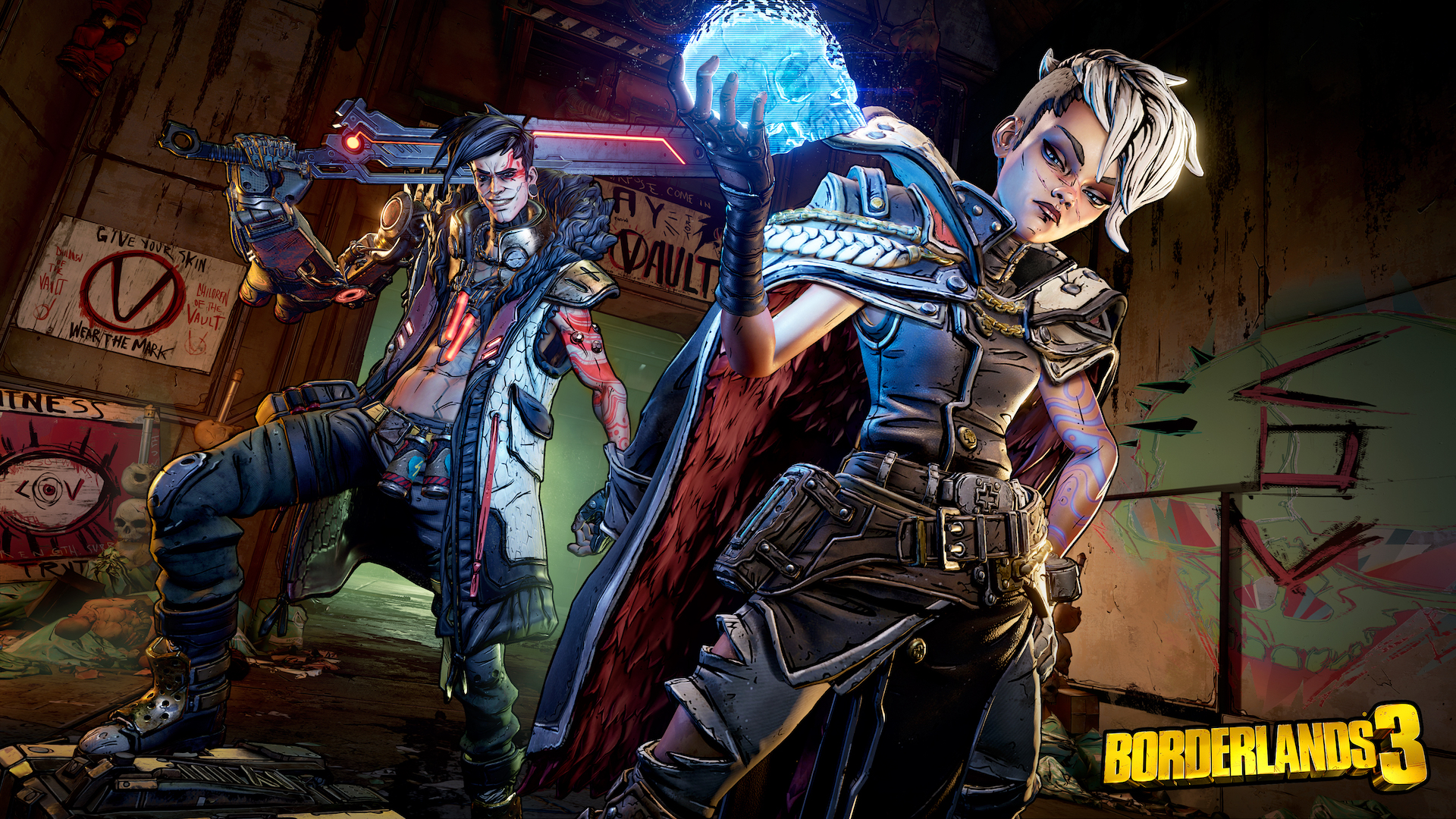Looting is bloody business. Whether it’s during a riot or during a war, no good ever came out of the desire to loot. It’s a crime born out of unrest and subjugation. It’s greed in its most chaotic form.
But video games know that “loot” is just a darned fun word. Forget the historical implications. It’s phonoesthetically goofy, thanks to the lilting L at the beginning, the loopy double-Os middle, and the stubborn T at the end. Translating the literal sound of the word into a gameplay mechanic, video games landed on an ever-increasing amount of sheer stuff, stuff that makes you stronger and better and more powerful, accompanied by an explosion of lights and colors and a dopamine rush of Atlantic City proportions. What’s not to love about loot?
The Borderlands series might not have created the current iteration of video game loot, but it sure as hell has perfected it. With Borderlands 3, Gearbox’s signature franchise has cemented its legacy as the Heisenberg of the loot game, for better and for worse.

Everywhere you look in Borderlands 3, loot’s popping out of enemy corpses like candy out of piñatas, and the ground is polluted in shining, colorful beacons. I mean, the entire narrative thrust of the series is about characters who are absolutely obsessed with discovering the best in-universe loot. Even the pause menu’s news ticker bombards you with calls-to-action to “Become a VIP Member for Loot!” and “Get merch on GearboxLoot.com!” The desire for loot that Borderlands 3 tries to instill is primal, but there’s also a hypocrisy deep within the game’s own messaging—if the bad guys desire more power, then they deserve to die, but if you desire more power, well, you’re just doing what comes naturally to every red-blooded Vault Hunter. Now get out there and lust, lust, lust for more.
Loot in Borderlands 3 is like oxygen: It’s everywhere and a key requirement to surviving, but if you have too much of it, you’re going to get dizzy and pass out. Feeling compelled to grab everything in sight will only lead to heartbreak within a few steps, when you stumble upon another pile of guns and shields and realize you’re out of room in your inventory. If you have trouble making decisions, then Borderlands 3 will become your new nightmare.
Figuring out the perfect amount of loot to give players has to be one of the weirdest challenges that modern shooter franchises like Borderlands, Destiny, and The Division have to overcome. Give players too much loot and it becomes meaningless; give them too little and they start to wonder why they’re even playing the game in the first place. Borderlands 3 had seven years to figure out this problem, seeing both Destiny and Division games launching within that span, and the answer it landed on was giving players as much as possible while also making the differences in the gear matter enough that they have to spend hours in menus figuring out what’s the best, most adaptable loadout they can build. That might be fun for some players (especially longtime Borderlands players), but it can also break up the flow of a session when you’re staring at a vending machine in between skirmishes, flipping back and forth between weapons and doing mental math to determine which gun you can bear to part with.

On the one hand, Borderlands 3 deserves props for making the differences in loot—not just in the amount of damage they do but also in how they perform and function—noticeable so early in your playthrough. Most other games like these have a handful of weapon variants, with the pros and cons of each style of gun only becoming obvious at higher levels. Borderlands 3’s nine weapon manufacturers each feel incredibly different, and the randomized elements like sights and damage type that determine how each weapon feels and plays meant that it was easy before my character even hit double-digits to know which ones I preferred and which ones stunk worse than a skag. Finding out that I’m a Hyperion™ Man early in my playthrough made digging through my big bag o’ loot a little more manageable. The specific details of each weapon don’t usually factor in Destiny and The Division, at least for as long as I play those games—which is generally up until I’m done with the main story and no further.
The same can be said about Borderlands 3’s four playable Vault Hunters. FL4K, Moze, Amara, and Zane are all different enough from previous Vault Hunters to make them feel special, but each one seems to take a little from everyone else. Zane, for instance, combines Zer0’s holographic decoys with Wilhelm’s drones, while Moze seems like a mix between Brick and Salvador. What differentiates Borderlands 3’s Vault Hunters from their counterparts in previous games is that the skill trees you focus on determine what action skill you can unleash, with Zane having two active skill slots at the cost of being able to use grenades.
My personal favorite, FL4K, was the most distinctive of all of them, thanks to their pets. I played through the entire campaign solo as FL4K, and it’s hard to imagine navigating the game’s relentlessly unkind landscape without the company of my faithful skag, Mr. Chew. Depending on which of FL4K’s three skill trees you decide to focus on, you can be as hands-on or -off with your pet as you want, though as a solo player, I found the balanced Master tree and its Gamma Burst action skill to be the most reliable and the most fun to explore. For all four Vault Hunters, the different skill trees make a true difference in how you approach each battle. They still mostly follow the formula of offensive, defensive, or balanced when it comes to their categories, but the way each action skill plays out makes the choices in skill trees matter more than they have in previous Borderlands.

Credit: 2K Games
What’s disappointing is that we’ll once again probably have to wait for the next game until this game’s Vault Hunters actually get their time to shine in a narrative sense. Lilith has slowly emerged as one of the driving forces in the series, but that wasn’t the case when she was just a simple Vault Hunter. She had to be elevated to the status of NPC to finally have some growth as a character. In Borderlands 3’s case, Maya (Borderlands 2’s Siren) plays a big role in the story—a much larger one than she had in the game where she was playable. Besides the opening cutscene, there’s never a moment where we see our characters interacting with the world from a third-person perspective. If some shit is going down in a major story cutscene, it’s always Lilith, Maya, or Maya’s ward Ava who are starring in the show, while whatever Vault Hunter(s) you’re playing as is conspicuously absent from the scene. Yes, you’ll still talk directly to these characters from a first-person perspective, but the Vault Hunters’ absence from pivotal cutscenes makes them feel largely like non-entities, despite the fact that they’re the ones actively killing all the bad guys. Maybe it’s an issue of technical limitations, but games have been including customized characters in cutscenes for ages, so it seems odd that Borderlands 3 can’t figure out a way to insert my top-hatted FL4K and neon Mr. Chew into the action.
That’s from where, I think, most of Borderlands 3’s narrative problems stem. It isn’t the cheesy humor or the poop jokes or even the main villains, the Calypso Twins, who aren’t as annoying or as cliché as some are making them out to be. (For what it’s worth, the streamer-parodying twins and their cult, the formation of which is undercooked, actually seem like prescient commentary in a world where a grown-ass man can bring a live broadcast into a public restroom and get away with a mere slap on the wrist from Twitch. Cults of personality are a real thing, folks, and most parents are just letting their kids get sucked in without even understanding what a streamer is.) The main problem with Borderlands 3’s story is that, even though you’re playing as a character with a defined look, name, and personality, that character isn’t growing or changing in a significant way. Unlike Destiny and The Division, where you play as a merely anonymous, immortal soldier in the never-ending battle between good and evil, Borderlands gives you a distinct personality to connect with, and then it never does anything with that. I’m not just one of a thousand Division agents hanging out at the White House—I’m one of four Vault Hunters and the only one that can prevent the end of the world. So why do I feel so anonymous?

It’s in these kinds of details where, again, Borderlands 3’s inherent contradictions come to light. As a sequel, it has to walk a fine line between being a Borderlands game and keeping up with the times. The new planets you’ll travel to are a breath of fresh visual air compared to the long-in-the-tooth wasteland of Pandora, but they’re still organized and sectioned off in bits and pieces, with narrow pathways and invisible barriers that make you go the long way whenever you want to get to a mission objective. Sliding and mantling make gunfights feel more active and modern, but you’ll still fight most of the bosses (not including Pain and Terror) by simply circling them and shooting until they’re dead.
Much about Borderlands 3 is different, but nothing feels like it’s actually changed. Are you the same person you were seven years ago? Well, Borderlands is, and whether or not that’s a good thing will depend entirely on what you want from the game. It looks and plays better than ever, but only in the service of a single-minded pursuit. At this point in gaming history, we’re drowning in the blood of our enemies and suffocating under piles and piles of colorful loot.
Header image credited to 2K Games
|
★★★☆☆
Borderlands 3 has finally arrived, seven years after the last numbered game in the series. But in that time, while most of us were growing older and wiser, Borderlands has doubled-down on its most prefrontal cortex obsessions. There’s more loot than ever, and it’s more individualized, but there’s very little room for other areas of growth, like in story or character. As busy as Borderlands 3 can feel, and as much as this game expands the universe, you’ll still feel like all you’re doing is keeping your nose on the ground, sniffing out shiny, colorful guns. |
Developer Gearbox Software Publisher 2K Games ESRB M - Mature Release Date 09.13.19 |
| Borderlands 3 is available on Xbox One, PlayStation 4, and PC. Primary version played was for Xbox One. Product was provided by 2K Games for the benefit of this coverage. EGM reviews on a scale of one to five stars. | |

Michael Goroff has written and edited for EGM since 2017. You can follow him on Twitter @gogogoroff.